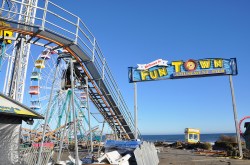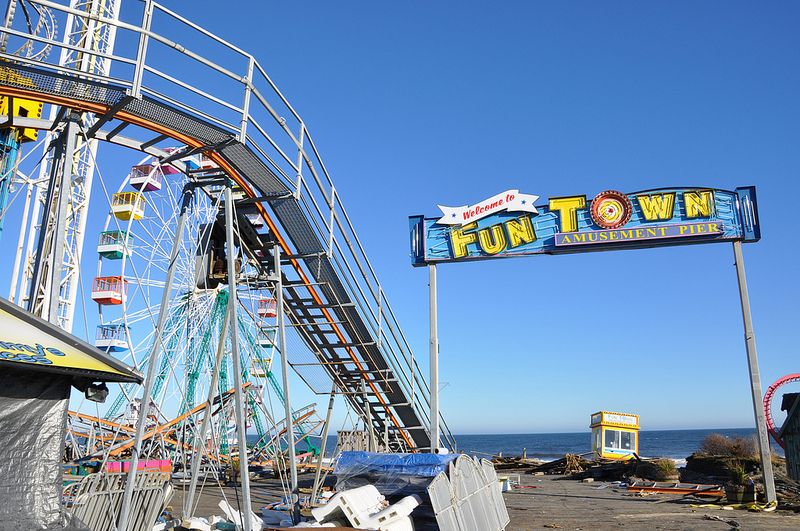
b0janglesHurricane Sandy took the fun out of the Jersey Shore.
As bikini season approaches, Jersey Shore beach towns are preparing for their annual influx of tourists. This year, that will mean more than dusting off the cotton candy machines and stocking up on vomit deodorizer. When Hurricane Sandy hit last fall, boardwalks from Long Branch to Atlantic City — including Seaside Heights, of Jersey Shore fame — were damaged or destroyed. The shore is now in a frenzy of rebuilding and repairing, gearing up for Memorial Day. But environmental activists have been something of a buzz-saw kill.
The decking of these boardwalks pre-Sandy ranged from southern yellow pine to wood-plastic composite lumber to a tropical hardwood called ipe. That last option has rainforest advocates and town officials at loggerheads. Ipe, also known as Brazilian walnut, is the Cadillac of decking materials, prized for its density, fire resistance, and durability. More than one town is considering using it for boardwalk material. Environmental groups, including Rainforest Relief, Friends of the Rainforest, and the New Jersey chapter of the Sierra Club, say tropical hardwoods are a poor choice environmentally speaking, particularly given the circumstances.
“What happens in the Brazilian rainforest [where ipe is often logged] affects the climate,” says Jeff Tittel, director of the Sierra Club’s New Jersey chapter. “It’s unconscionable to add to climate disruption when you’ve just been destroyed by an environmental disaster that was caused by climate disruption.”
It’s been estimated that as much as 80 percent of the logging conducted in the Brazilian Amazon is illegal. And some activists say harvesting a tree like ipe — with only one or two growing in a given acre — is a devastating affair even under legal circumstances. Logging requires roads, and neighboring trees are often incidentally felled, they say. And since old-growth tropical rainforest supports the greatest biodiversity on the planet, says Tim Keating of Rainforest Relief, every injury is magnified. “You damage ecosystems there, you’re automatically losing species,” he says. “These are the genetic libraries of Mother Earth and we are burning them down to make boardwalks.”
Well, if that doesn’t just drop a doggy bomb on your beach towel …
The battle over tropical hardwoods long precedes Superstorm Sandy. In the 1990s, Atlantic City and Avon-by-the-Sea rebuilt their boardwalks with ipe, despite protests from environmentalists. In 2007, activists convinced Ocean City not to use ipe to rebuild its boardwalk. But in 2009, Wildwood replaced a section of its boardwalk with ipe after having pledged to use black locust.
Post-Sandy, activists have had some successes. The borough of Belmar had planned to use ipe to rebuild its boardwalk but in January reluctantly decided against it after environmentalists threatened to sue, potentially slowing reconstruction. “We cannot allow out-of-town interests to hold our community and small business owners hostage,” Mayor Matthew Doherty told the Asbury Park Press.
And in New York City, Mayor Michael Bloomberg says that the Rockaways boardwalk, heavily damaged by Sandy, will not be rebuilt with tropical hardwood. The city is one of the largest consumers of the stuff in North America. The Highline, South Street Seaport, the Brooklyn Bridge — they’re all decked with tropical hardwoods. (One group even wants to designate a rainforest in Guatemala as the Brooklyn Bridge Forest, for future repairs.) But in 2008, under pressure from environmental groups, the Parks Department pledged to reduce the use of tropical hardwoods and, Keating says, has begun to follow through.
Yet little Avon-by-the-Sea remains a hard nut to crack. The borough plans to rebuild its three-quarter-mile boardwalk with ipe, despite letters, petitions, complaints to the Federal Emergency Management Agency (75 percent of the $1.5 million tab for rebuilding the boardwalk will come from FEMA), and threats of a boycott and to sue. Keating estimates that some 766 acres of tropical rainforest will have been felled for Avon’s boardwalk. That’s about twice the size of Avon itself. He and other activists are advocating for recycled plastic lumber or sustainably harvested domestic hardwood instead.
But borough administrator Tim Gallagher says their arguments — much like ipe itself — don’t hold water. “We’re happy with the product that we chose and we think it’s more environmentally friendly than the other stuff,” he says. Gallagher says the durability of ipe means it won’t need to be replaced as quickly. (Avon’s first ipe boardwalk was built in 1993 after a storm destroyed the previous incarnation.) And, Gallagher says, the wood Avon has purchased — it’s already en route — has been certified by the Forest Stewardship Council (FSC), an international nonprofit forest management organization.
Here’s where things get a little … knotty. Those protesting the use of ipe don’t put stock in the FSC certification process when it comes to the tropics. Keating maintains it’s likely impossible to harvest wood sustainably from such a complex ecosystem, with such long-lived species. “Ipe trees are 250 to 1,000 years old,” he says. “How are you gonna have a 25-year management plan?” And the methods of the FSC have repeatedly come under fire. One of its founding members, who now runs an FSC watchdog group, has called the organization “the Enron of forestry.” Many environmental organizations, including the World Wildlife Fund and the Wildlife Conservation Society, continue to support it, but Greenpeace International recently produced a critical report [PDF], and some environmental advocacy groups — like Europe’s FERN — no longer endorse it.
This is not a debate Gallagher cares to join. “It’s a done deal,” he says. “We’re using ipe.” But seasoned boardwalk battler Georgina Shanley, a founding member of Friends of the Rainforest, is holding out hope. Shanley helped convince Ocean City to avoid ipe in 2007, and in that case the town already had the wood. “I really believe we’re going to fight this to the very end and we’re going to win,” she says.
Even if she’s victorious this time, rainforest advocates aren’t out of the woods. Shanley likens these ongoing battles along the Shore to a boardwalk arcade game, the one where crocodiles emerge one after the other and the player must hit them on the head with a hammer before they disappear. “Another one will pop up,” she says. “I have no doubt.”



